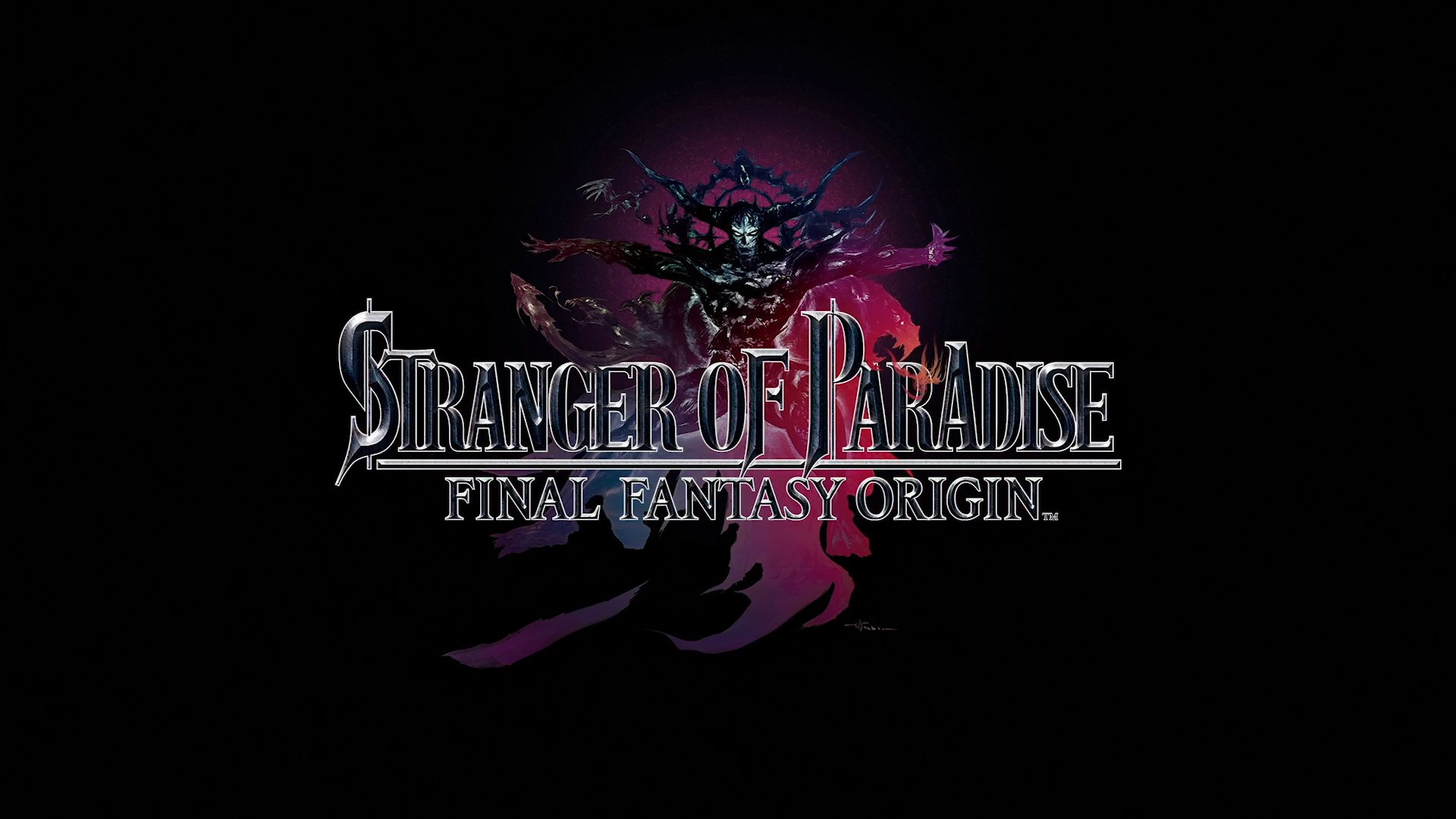E3 is back with, well, not quite a vengeance, but at the very least a modest grudge. E3 2021 may have ultimately been realized as a digital event without live attendees, but there were still plenty of exciting announcements, along with the ability to try out certain game demos at home, without necessitating the expensive trip to Los Angeles. Many of these demos were for independent games, such as the offerings presented within Steam’s Next Fest, or Xbox’s Summer Games Fest. In at least one case however, Square Enix happened to offer a brief window to play test its newly-announced triple-A masocore RPG spin-off, Stranger of Paradise: Final Fantasy Origin!… If you own a PS5.
Considering the infamous shortages and frustrating inability for many interested gamers to get ahold of Sony’s next-gen console since its launch last November, that’s a bigger caveat than you would initially imagine. Despite the fact that Stranger of Paradise: Final Fantasy Origin is also planned for release on PS4 next year, alongside PC and Xbox consoles, the game’s exclusive E3 demo was only offered on a next-gen console that relatively few people own at this point, sadly cutting off a sizable chunk of RPG fans and Final Fantasy loyalists from taking Stranger of Paradise for a test run. I assume that another demo will eventually be made available on PS4, PC and Xbox in the near future, but for now, hopefully you’re one of the lucky few that managed to snag an elusive PS5, and got a chance to try the game demo while it was available.
Fortunately, I was able to do a lengthy play test of Stranger of Paradise’s flagship PS5 build, sampling its multiple difficulty levels, flexible class system, and predictably punishing battle mechanics. That stark masocore challenge is present and accounted for here for sure, though Stranger of Paradise offering customizable difficulty settings, including an Easy Mode, stands as a notable effort to make the game more widely accessible than Dark Souls or Nioh. Masocore fans would likely meet that prospect with contempt, since the Dark Souls-inspired mould suffers from no shortage of gatekeeping, often to a fault, as masocore games are chiefly made to reward persistence over sheer skill. Despite its entirely optional lower difficulty setting however, Stranger of Paradise is still a full-blooded masocore game, being developed by Nioh and Ninja Gaiden studio, Team Ninja, who stand alongside From Software as some of the greatest masters of challenging, yet highly rewarding game design.
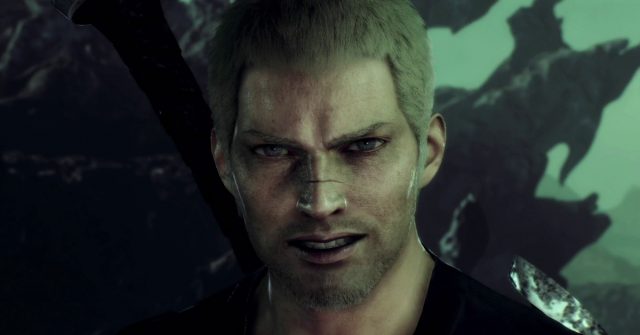
I can also safely attest that, despite my own considerable gaming skill, robust patience and long history with the Final Fantasy franchise, Stranger of Paradise’s demo build messed me up the first time I tried to run through it on its Normal difficulty setting. Even lowly goblins will shred through your HP in no time if you don’t know how to properly engage them, something that was just a little humiliating for someone like me that first got into the Final Fantasy franchise with its very first NES game (fashionably late during the mid-90’s), where even an unarmed White Mage could punch their way through a small goblin horde without breaking too much of a sweat. Why does that matter, you ask? Well, it feels relevant when Stranger of Paradise takes place in a reimagining of the original Final Fantasy game’s setting, a disaster-plagued world where the forces of the elements must be restored by the mysterious Warriors of Light.
Stranger of Paradise is not inherently a remake, sequel or prequel to the original Final Fantasy game though, according to its developers. The setting is the same, but unlike the original Final Fantasy title, where players could craft a four-man party of their choosing from six basic character classes, Stranger of Paradise instead appears to have one pivotal protagonist and player character, Jack, who meets various A.I.-controlled allies on whatever mysterious journey he’s undertaking. Jack seems to have found himself in the original Final Fantasy game’s world for reasons unknown, and the mystery of Jack’s presence in this world, with Jack no doubt being the eponymous ‘Stranger of Paradise’, is bound to be a key question throughout this game’s storyline.
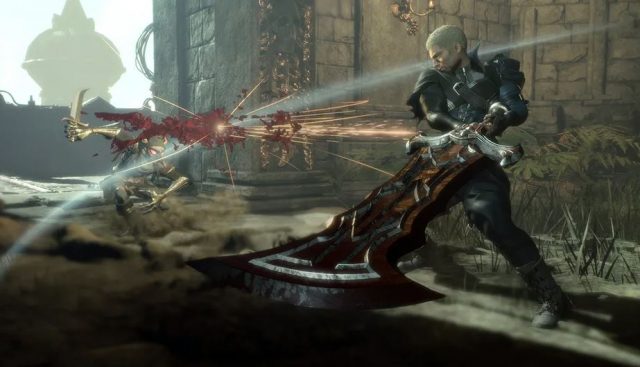
That being said, Stranger of Paradise’s PS5 demo was noticeably light on story during my play test. Instead, Jack’s meme-inviting, oft-announced quest to kill Chaos (appropriately, Chaos is the final boss of the original Final Fantasy game), served as all the motivation and direction I received. I was also flanked by two allies, Jed and Ash, both living embodiments of participation ribbons, who made for useful distractions while I was surrounded by foes or relentlessly assaulted by the demo boss, Garland (more on him later), and not much else. Fortunately, Jack himself is very empowered as a player character, having more than enough ways to defend himself, once you wrap your head around Stranger of Paradise’s fundamental mechanics.
If you’ve played a masocore RPG before, some of these mechanics will be familiar to you. Jack can strike enemies with R1, guard against enemy attacks with L1, dodge roll with the X Button, and use the R2 Button for special techniques and magic, depending on which Job (read: character class) you currently have active. Even better is the fact that Stranger of Paradise doesn’t have a stamina meter limiting your moveset, so you’re only as inhibited as the deliberate animations of Jack’s attacks. Instead, Stranger of Paradise governs the use of your abilities between an MP Gauge, something that should be very familiar to Final Fantasy fans and RPG enthusiasts in general, and a Break Gauge, an all-new addition to this particular spin-off. These two special gauges have a bit of a symbiotic relationship, with players restoring MP by using the Circle Button to perform a parry, which cancels an enemy attack’s damage, and grants some MP in return. Parries further reduce the Break Gauge in response however, something that’s also reduced if you take damage. If the Break Gauge is depleted, Jack will be briefly stunned and unable to act, effectively giving enemies a free series of hits on you. Needless to say, considering how punishing Stranger of Paradise’s enemies are, that’s a bad time, though enemies do have their own Break Gauges as well, so you could turn the tables on them with a relentless enough attack strategy.
Balancing your MP gauge, your Break Gauge and your offensive and defensive maneuvers overall is the key to success in Stranger of Paradise. It will probably take those inexperienced with masocore games in particular a bit of practice to get a handle on these mechanics, and believe me, I suffered quite a few early deaths on the Normal difficulty setting while doing so. Fortunately, the penalty for death in Stranger of Paradise is a bit less severe than, say, a Dark Souls game. Players can touch checkpoints in the demo that serve as respawn locations if you die, with the only noticeable consequences from death being that any loot you failed to grab from enemies (or dropped yourself) will disappear, and depleted MP will remain depleted. Having to respawn will certainly kick you backward, though it will also restore your health, and allow you to keep any upgrades and loot that you did manage to successfully attain during your previous run, thus securing that core theme of persistence that any worthy masocore game defines its progression around. You’ll die and die again, but as you keep pushing ahead, you’ll keep becoming gradually more powerful, and gradually more able to withstand the game’s brutal enemies.
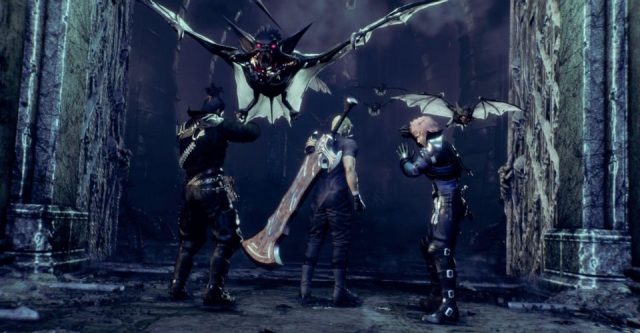
The demo’s nostalgic, if ominous setting of the Temple of Fiends should also tickle longtime Final Fantasy fans that are familiar with the series’ original 8-bit adventure, or perhaps one of its several remakes. Even a subtle musical flourish occasionally repeats the iconic sequence of notes from the Temple of Fiends theme present in the original Final Fantasy game (it was also used within the original Final Fantasy’s underwater dungeon that leads to the Water Fiend, Kraken), though the heady, atmospheric musical composition is all about instilling dread, rather than packing in a more exciting throwback score. There isn’t a ton of variation in the demo’s music either, which may be disappointing to some, though with such an intense demand for concentration in battle, it’s inevitable that Stranger of Paradise wouldn’t want an overbearing soundtrack that would only serve to distract players.
The demo’s familiar enemy variety also contains a strong mix of nostalgia and fear, starting with relatively lowly goblins, who mercilessly swing daggers and deviously charge the player when they’re distracted. Goblins at least have the advantage of telegraphing their attacks though, and that was especially important to remember when the end of the first demo section pitted me against a more powerful and dangerous Goblin Guard! This enemy happened to be vomited up by a monster vent, which occasionally appear during certain sections of the game. Monster vents continually spawn enemies until they’re destroyed, though defeating the monsters they eject helps lower their defenses, and eventually leaves them wide open to a series of finishing attacks. Destroying a monster vent is often a guaranteed way to open a path forward to boot, whether it’s knocking away a weak wall, or collapsing a tower or pillar that can then serve as an improvised bridge over a chasm.
Certain points of the demo also give the player some options when it comes to how to engage enemies. There were, for example, a few hallways lined with dry grass that also happened to be populated by Bombs, a very recognizable Final Fantasy monster (albeit one that didn’t actually debut in the series until 1988’s Final Fantasy II, the real one, not the disguised Final Fantasy IV from 1991!), whose fiery breath and dangerous fireballs would frequently ignite the grass, resulting in continual damage until I ducked into side balconies and doorways. Manipulation of the environment can often be a good way to get the drop on enemies as well, and that’s where magic use becomes essential. After picking up a club that allowed me to unlock a spellcasting class, the Mage class, I could charge up spells like Watera and Waterga to put out fires, or Fira and Firaga to ignite dry grass right back, for example, something that was especially handy when I eventually figured out how to corner and defeat another iconic Final Fantasy monster, the vicious, fast-fleeing Cactuar! That is, after its signature ‘1,000 Needles’ move quickly killed me and my party at least a few times over.
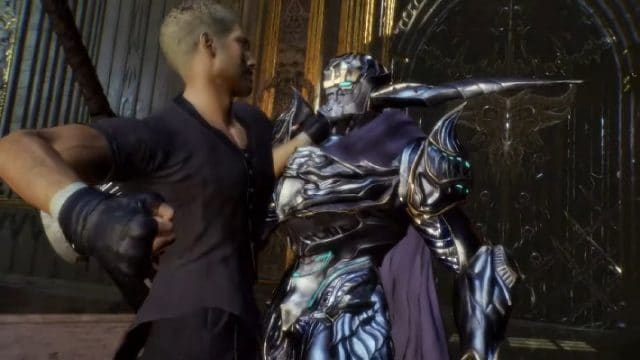
Here however is where one of the issues with Stranger of Paradise’s gameplay tends to crop up; Jack’s overall sluggishness. Spellcasting, to be fair, feels fine though, even if charging up spells leaves you rooted in place and quite vulnerable to being interrupted by enemy attacks. Still, I do like the mechanic of staying in place to increase a spell’s power, or firing off a weaker spell instantly to better remain on the move. As an example, you can instantly cast Fire by tapping R2 after locking on to an enemy, or hold R2 to charge it into Fira, and then Firaga, for gradually greater damage and area-of-effect. This is another smart risk/reward system that helps combat feel more dynamic and engaging.
Despite this solid magic mechanic however, using base attacks with R1 can be a little too heavy in many cases, especially when you have to struggle to move Jack around enough to take on a crowd of enemies. You do have a crowd-controlling ability called Lightbringer automatically assigned to Jack in the demo, which can empower him by preventing him from being stunned, while also knocking any surrounding enemies away when it’s activated, but there’s no denying that Jack’s sword attacks in particular are sluggish and unwieldy during more intense combat encounters. I imagine that this is an intentional effort to try and copy the combat style of Dark Souls, but the difference there is that Dark Souls’ enemies were designed around the player being very slow and deliberate. In Stranger of Paradise however, enemies are often agile and vicious, as if they’re designed for Nioh or Sekiro: Shadows Die Twice. That becomes an especially big problem when you make it to Garland, and believe me, I’m still planning to address that humiliation in due time.
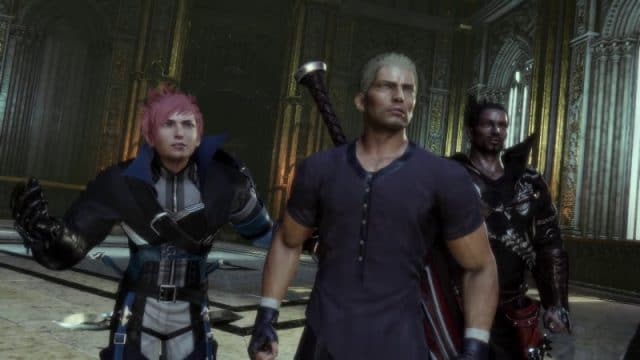
Fortunately, a plus on this note is the fact that players can design Job presets, each with their own equipped loot and ability selections, and easily switch between two preferred Jobs with a tap of the Triangle Button. Not only that, but as long as you have a Job preset equipped, that Job will continue to gain Job Levels as you defeat enemies, thus unlocking new command-based abilities and stat boosts, even if you never swap to it. The demo offered three potential Jobs for Jack to attain, starting with Swordsman, and eventually expanding to include Mage and Lancer. These Jobs also offered upgraded Job Classes that could eventually be unlocked on a simple Skill Tree-like node system (i.e. spending Job Points to unlock a skill or stat boost makes adjacent nodes able to be unlocked), with Swordsman advancing to Warrior, Mage upgrading to Black Mage, and Lancer rising to Dragoon. This allowed me to take Jack’s basic Job skills and stats even further as I played on (particularly since Jack doesn’t appear to have a base character level in this game, only Job levels), and for those brave enough to play this demo on Hard difficulty, you’ll potentially be able to attain even more valuable skills and loot, if you have the finesse and patience to survive, of course!
The enemy variety in the Stranger of Paradise demo wasn’t bad either, even if there was still some repetition, especially among the Goblins and Bombs. Later sections of the demo area however eventually gave way to Wolves, Leech Bats and Skeletons, and even an armoured Griffon towards the end, who guarded a particularly valuable treasure cache! Leech Bats prove to be particularly troublesome foes, with their sonic screeching stunning and continually damaging Jack and his allies, if you aren’t quick enough to guard with the L1 Button, and that’s before considering how frustratingly difficult they are to hit! Honestly, encounters with Leech Bats felt like the one time the range-based Lancer/Dragoon Job came in handy for me too, which otherwise didn’t feel all that tantalizing compared to the Swordsman/Warrior Job, once I adjusted to how weirdly slow Jack can be with his sword strikes.
Of course, if anyone is talking about anything surrounding the Stranger of Paradise demo, it’s the Garland boss fight at the demo’s climax. I confess that the first time I challenged Garland, the hulking knight that serves as the vessel of Chaos in the original Final Fantasy game (uh, spoilers for a nearly 34-year-old game, I guess?), he wiped the floor with me, over, and over, and over again. Garland is a speedy, relentless foe, one that demands you master the art of parrying between his ultra-quick sword strikes and lunges, as well as his fire enchantments that further increase the outstanding range of his attacks.
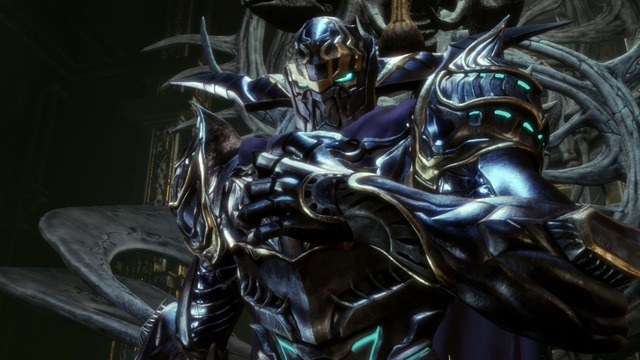
This boss fight is where Jack’s lumbering lack of speed becomes a serious problem. I was able to get Garland’s pattern down with some practice, but the amount of ground he can cover in the battle area is insane, and frankly, a bit excessive. It doesn’t feel like a legitimate challenge when Jack’s Break Gauge is sliced through like butter by Garland’s moves either, especially when Garland can clear half the battlefield in an instant, while I have to hope that Jed and Ash can keep Garland busy for a bit whenever I need to mash the X Button and dodge roll away in order to recover my flagging Break Gauge. That said, this strategy only works until my brave, but frustratingly ineffectual companions inevitable die, forcing me to debate using one of my five valuable Potions (which heal you or revive an ally by pressing the Down Directional Button, much like the Estus Flasks of Dark Souls), or trying to fight Garland without allies. Naturally, battling Garland is even harder when you have his undivided attention.
Eventually, I managed to get Garland’s HP down enough to stun him and break him, using the Circle Button when the prompt flashed (which normally instantly kills broken enemies and converts them into MP with a rather cool ‘blood crystal’ effect), but this only made him more dangerous. Now, Garland gained an ice-type enchantment that only increased his range further, and broke through my Break Gauge even faster! I confess as well that after fifty or so failed attempts that comprised being broken, instantly killed, and getting annoyed enough to temporarily lose Garland’s speedy, demanding battle pattern on subsequent endeavours, I eventually relented and retried the demo on Easy difficulty. No, there doesn’t appear to be an ability to decrease (or increase) the game difficulty during gameplay, and that’s a bummer. Regardless, playing on Easy suddenly gave me an incredible advantage. I only died once, and it was on purpose, namely when I tried to see how long Jack could hold out while fighting several Bombs within burning grass. Even Garland was helpless to stop me at this point, now that I already had plenty of practice parrying and dodging his attacks. Hell, I simply powered up my Black Mage Job as much as I could this time, and then devastated Garland with Blizzaga and Thundaga from a distance until he cried uncle!
This gap between Easy and Normal is quite substantial, and the leap to Hard can be similarly jarring, if you’re looking for a particularly stiff challenge! Now, before you judge me too harshly for relenting on the Garland fight initially, I did eventually play through the demo on Normal again, and between a virtually maxed out Warrior/Black Mage combo for Jack, along with a lucky break with Jed’s and Ash’s unlikely survival, I did eventually defeat Garland on the Normal setting. This was a hard-earned victory, but it did feel satisfying, even if I didn’t dare challenge Garland on the Hard setting. Masocore bosses certainly make you work for your success, this much is true, but Stranger of Paradise nonetheless needs some balance tweaks before it’s ready for primetime. Either Jack needs to be sped up, or certain enemies (Garland in particular!) need to be slowed down. Jed and Ash are all but useless as anything beyond a method of drawing enemy attacks away from you as well, especially when you can’t manually command them to use their own specific attacks and abilities against Stranger of Paradise’s incredibly dangerous enemies.
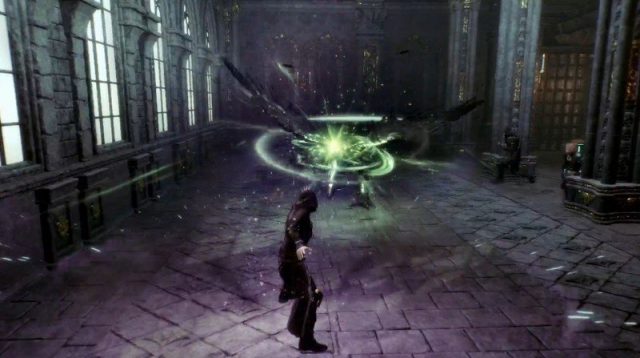
I was also disappointed to see that, from a technical standpoint, Stranger of Paradise feels noticeably beneath Square Enix Japan’s usual presentation prowess. In fact, at worst, Stranger of Paradise can look downright ugly by PS5 standards. The game’s bleak visual palette doesn’t lend itself well to the Final Fantasy franchise’s usual bright colours and ridiculously ornate character designs, both of which appear to be considerably toned down in Stranger of Paradise. It was also frustrating that a PS5 build of a masocore game (even an early one) with surprisingly modest graphics forces players to choose between true 4K resolution and steady 60fps performance. Choosing Performance Mode in this case is a no-brainer too, because the visuals in Stranger of Paradise aren’t nearly good enough to properly benefit from prioritizing a true 4K presentation.
Even in Performance Mode however, the Stranger of Paradise demo had some unwelcome framerate hiccups, if only for a second at a time. That makes the ill-fitting graphics sting even more, though I’d also estimate that these framerate disturbances are an early build bug that will probably be smoothed out in the game’s final product. On that note, I’ve heard from reliable sources that Stranger of Paradise was not originally conceived as a Final Fantasy game, and honestly, I don’t find that hard to believe. Its visual palette quite clearly emulates franchises like Dark Souls more than Final Fantasy, even while certain iconic Final Fantasy monsters like Bombs and Cactuars occasionally cropped up during my trek through the fairly linear Temple of Fiends. That would be potentially intriguing, but Stranger of Paradise currently resembling an early-era PS4 game, and just barely hovering above a high-end PS3 game at worst, doesn’t help this new take on a Final Fantasy environment excel to say the least!
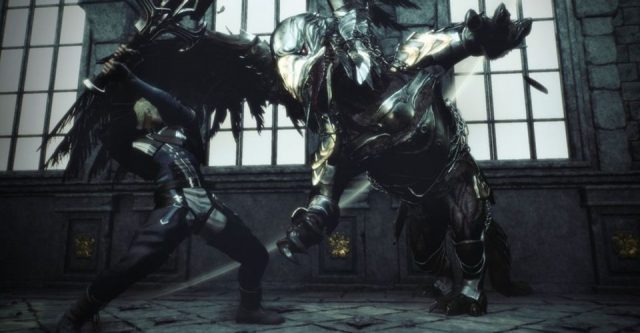
Stranger of Paradise could definitely use more time in the cooker, because some of it feels quite rough in its preview build. I will say however that I still had fun with its combat, once I got a proper handle on it, and I did appreciate some of the ways that the game separates itself from its obvious masocore inspirations. The ability to switch between two Job presets with a button tap is great, as is the great flexibility offered between just a sampling of Jack’s potential abilities. The Break Gauge system could use some balance tweaks, but in concept, it’s another clever risk/reward template that dares you to stay on the offensive, though not to the point where you forget to dodge, guard and parry enemy attacks. The parry system is also pretty neat in fact, even if the strain on your Break Gauge caused by relying on it feels excessively punishing, especially when you’re fighting Garland.
I don’t currently get the impression that Stranger of Paradise is going to steal the crown from champion masocore properties like Dark Souls, Nioh and Sekiro, but as a brutal, foreboding new flavour of Final Fantasy, it’s not without potential. I had more fun with this Stranger of Paradise demo than I did with even some of those aforementioned masocore greats, warts and all, plus the flexible difficulty settings and suite of abilities on offer in Stranger of Paradise do promise to make the game more malleable and inviting than your everyday masocore RPG, which often punishes any desire to experiment or play with the rules of battle. Whether you don’t want excessively tough enemies to bar you from further experiencing the story, or you’re looking to punish yourself with a whole new degree of monster-slaying pain, Stranger of Paradise has got you covered. If it can just beef up its technical presentation and smooth out the rough edges in its gameplay formula, the new Final Fantasy Origin brand could utilize Stranger of Paradise to launch another fan-favourite subseries-in-the-making for the world’s biggest RPG franchise.
“Stranger of Paradise: Final Fantasy Origin” is planned for release in 2022, on PS5, PS4, Xbox Series X|S, Xbox One and PC

